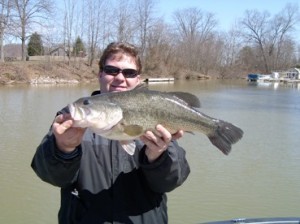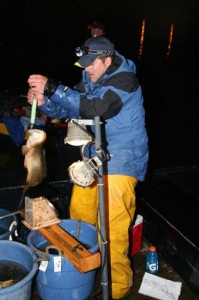Fishery
 ONLINE BOAT REGISTRATION NOW AVAILABLE!!!
ONLINE BOAT REGISTRATION NOW AVAILABLE!!!
Lake Lemon Boating/Fishing Codes of Conduct
Lake Lemon has been a popular fishing spot for Indiana anglers for many years. In the February 2010 edition of Indiana Game & Fish, Lake Lemon ranked among the top bass fisheries in the state. Fishery surveys were completed in 2000 and 2009 in order to check current status and long term trends to the fishery. The productive and well balanced fish community offers anglers many different opportunities.
During the 2009 survey a total of 2555 fish weighing 782.62 pounds and representing twenty-eight species were collected from Lake Lemon. Bluegill, Gizzard shad, Largemouth bass, Yellow bass and Crappie represent over 86% of the total fishery. All other species collectively represented 14.4% of total abundance and on average less than 1 % of total abundance individually.
Reports and results from the 2000, 2009, and 2017 surveys may be found by clicking the links below.
2000 Fishery Survey, 2009 Fishery Survey 2017 Fishery Survey
 Between the 2000 and 2009 fishery surveys the largemouth bass catch increased by 48%. Adult Gizzard shad and Yellow bass populations, which compete for resources with juvenile largemouth bass, have decreased since the 2000 survey. This may largely be due reduction of milfoil coverage and bag limit restrictions. The LLCD also seeks to minimize impacts of over fishing by not allowing fishing tournaments to be held on Sundays or during the months of July and August.
Between the 2000 and 2009 fishery surveys the largemouth bass catch increased by 48%. Adult Gizzard shad and Yellow bass populations, which compete for resources with juvenile largemouth bass, have decreased since the 2000 survey. This may largely be due reduction of milfoil coverage and bag limit restrictions. The LLCD also seeks to minimize impacts of over fishing by not allowing fishing tournaments to be held on Sundays or during the months of July and August.
Clubs and organizations interested in holding fishing tournaments need to complete the Tournament Application.
Please click Here for a printable Lake Lemon Fishing map.
The following best management practices, have helped protect and enhance the fishery at Lake Lemon:
- Maintain a 14.0 inch minimum length limit on largemouth bass along with limits on bass tournament sizes and timing that were established following the 2000 survey.
- Maintain maximum harvest of bluegill and yellow bass in order to reduce overall numbers allowing for increased growth rates.
- Encourage homeowners and watershed residents to reduce siltation and nutrient inputs into the lake.
- Continue selective herbicide control of Eurasian watermilfoil and continue with winter drawdowns. The combination of these two management strategies has effectively controlled milfoil in the past. In addition, the drawdown may be having positive impacts on the fish community by reducing the shad population. Native vegetation control should be limited to high use areas only.
- Require anglers and tournament fishermen to fill out creel survey sheets.
- Continue addition of fish structure (artificial and/or natural) along shore and in deeper water. In addition, residents should be encouraged to allow emergent vegetation to grow along lake margins. This habitat is an important nursery area for a variety of fish and wildlife,;will help filter water as it enters the lake; and discourage geese from grazing in yards.
- Complete another standard survey in 2012. The need for surveys is increased due to the abundance of gizzard shad. If shad numbers continue to increase, additional management strategies will be needed to combat this problem. Once shad become overpopulated they can be detrimental to a fish community and virtually impossible to control.
Our Address & Map
- office@lakelemon.org
- TEL: (812) 334-0233
- FAX: (812) 335-0038
- 7599 North Tunnel Road, Unionville, IN 47468
Latest News
-
2024 August Cruise-In
Lake Lemon is rolling out its first-ever Cruise-In event next month on Saturday […]
-
July 20th 2024, Board Meeting
The next regularly scheduled LLCD board meeting, and first public budget discussion, will take […]
-
The Beach Opens at Riddle Point
Summer has crept in fast this year, are you ready to kick it […]
-
2024 Fireworks Show!
Mark your calendars! The 31st annual Lake Lemon Riddle Point Park fireworks show […]
-
2024 Eclipse Recap
Reflecting on the Eclipse one week later and I am still in awe […]

